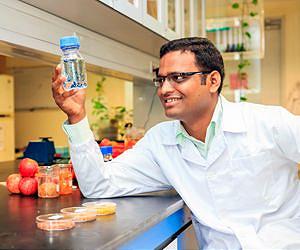
NUS researchers developed world's first water treatment techniques using apple and tomato peels
Staff Writers, Singapore
Singapore (SPX) Jul 23, 2013
|
|
One of the most crucial problems affecting the world today is the scarcity of potable water. In a bid to make clean water available at low cost, Mr Ramakrishna Mallampati, a PhD candidate at the National University of Singapore (NUS), experimented with water treatment techniques using materials that are easily available, and came up with novel ways to purify water using the peels of apples and tomatoes. This is the first time that the peels of the two fruits have been used to remove different types of pollutants in water.
The studies were conducted under the guidance of Associate Professor Suresh Valiyaveettil of the Department of Chemistry at the NUS Faculty of Science. The NUS team hopes that their water purification methods can benefit communities living in places where there is little electricity or resources to set up a water purification plant.
Scarcity of clean water
The scarcity of clean water is expected to worsen in the future due to over usage, lack of conservation methods and dwindling natural supply of clean water, even in countries with significant water resources.
Many hazardous pollutants enter the water supply through many channels, including waste disposal, industry effluent release or rain water drainage. Such pollutants need to be removed before the water can be consumed. However, most water purification technologies are not accessible to economically disadvantaged people around the world.
The challenge for scientists is to develop robust water purification methods that could carry out water treatment at low cost, with minimal energy consumption and using less chemicals in the process so as to reduce negative impact on the environment.
Tomato peel: an efficient adsorbent for water purification
Tomato is the second most consumed vegetable in the world, with approximately 30 per cent consumed as processed products. The disposal of the tomato skin and its other fibrous materials is an economic waste for many food processing industries.
Mr Ramakrishna evaluated the effectiveness of tomato peel as an adsorbent by using different pollutants. He also studied the structure of the tomato peels to assess their efficiency as biomaterials to remove toxic metal ions and organic pollutants from water. In addition, factors such as the pH, nature and amount of adsorbent used for extraction were considered to establish the optimum conditions under which tomato peel could remove various pollutants from water.
His study revealed that tomato peels can effectively remove different contaminants in water, including dissolved organic and inorganic chemicals, dyes and pesticides, and they can also be used in large scale applications. The results were published in the Royal Society of Chemistry journal RSC Advances in September 2012.
Apple peel: a biomass for water purification
In addition to tomato peels, Mr Ramakrishna also explored the viability of using the peels of apples for water purification, as apple peels are easily available as biowaste from food processing industries and they are biodegradable.
Similar to tomato peels, apple peels can also remove a range of dissolved water pollutants through the adsorption process. In order to enhance the ability of apple peels towards extraction of negatively charged pollutants, Mr Ramakrishna immobilised naturally occurring zirconium oxides onto the surface of apple peels. Zirconium loaded apple peels were found to be able to extract anions such as phosphate, arsenate, arsenite, and chromate ions from aqueous solutions. This method of water purification can also be used for large scale applications.
The findings are published in the American Chemical Society journal ACS Applied Materials and Interfaces in May 2013.
Research findings to benefit communities living in remote villages
Both Mr Ramakrishna and Assoc Prof Suresh hope that the findings on the use apple and tomato peels for water purification can be applied to benefit economically and technologically disadvantaged farmers living in remote villages, who depend on contaminated ground water or local rivers for their daily water needs. They intend to work with non-governmental organisations to transfer their research findings and knowledge to benefit the people.
Mr Ramakrishna and other students in Assoc Prof Suresh's research group are now looking into the use of other fruit peels and natural fibers for water purification.

